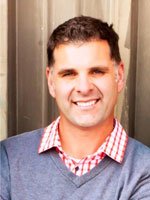This month we profile Michael Neff, PGA, who was awarded the 2021 PNW PGA Teacher of the Year award. For those who missed the special awards ceremony at Inglewood GC on March 20, we asked Michael to recap his success in 2021, his unique analysis of the golf swing and his much-talked-about golf training aid, GEARS. Plus, learn how the “nipper curve” got its name!
Facility: GEARS Golf
Hometown: Portland, OR
PGA Member Since: 1996
How did you get started in your golf career and who were your mentors?
I got my first job in the golf business at Bonneville Golf Course in Salt Lake City while I was attending University of Utah. I played college golf at BYU Hawaii and I realized I would not play professionally while I was playing college golf. I really didn’t want to do anything else, so I found my way in golf through that channel.
My mentors are:
- Dick Kramer – Utah Section
- Cathy Mant – Head Golf Coach at Georgia State University
- Bryan Tunstill – PNW PGA Past President & Columbia Edgewater CC
- Dominic Marconi – Oregon Chapter ED
- Adrian Burtner – Columbia Edgewater CC
- Jim Dunlap
- Craig Griswold – The Reserve Vineyards & GC
Can you tell us a little bit about your unique analysis of the golf swing, screening techniques and the “nipper curve”?
Gears is the only product in golf that measures both the body and the entire club at the same time, at research-grade accuracy. This has allowed instructors to measure very important aspects of both the body and the club that cannot be seen by the naked eye or with your typical 2-D camera view analysis. It also allows you to overlay or compare one swing via the next. This helps you see and feel the changes you are trying to make. The value of this is improved comprehension, diagnostics and speed of learning the principles you are teaching.
Nipper curve is a kind of a play on words. Nipper is my nickname (from being the youngest in my family) and the curve is the lie angle curve that we would bend a set of clubs to. The generic curve with most clubs has the wedges at 64-degree lie angle and going down to 58-degree lie angle for the 3 iron (roughly at 6-degree curve). My curve is based on robot testing and how the shaft droops. The longer the shaft the more it droops, so the Nipper curve is bending the lie to compensate for the amount of shaft droop. The wedges end up being flatter and the long irons end up being more upright. This process makes them all roughly the same lie angle. So it’s really not a curve. More like a flat line.
The Nipper curve is kind of a funny way for me to explain how to bend clubs to compensate for shaft droop. For example, let’s say you demo a 7 iron and you hit a std lie 7 iron perfect and exactly how you want. Let’s say that lie angle is 61 degrees. What I am saying is that all of your clubs will be roughly 61 degrees (give or take a little here or there to compensate for irregularities in the shaft itself). If all your clubs are 61, then that means your wedges are flatter and your long irons are more upright.
These players have had a unique amount of success with this:
- Tony Finau – PGA Tour
- Kevin Kisner – PGA Tour
- Rickie Fowler – PGA Tour
- Bryson DeChambeau – PGA Tour
- Gaby Lopez – LPGA Tour
- Ryann O’Toole – LPGA Tour
- Dana Finkelstein – LPGA Tour
- Jenny Coleman – LPGA Tour
- Mickey DeMorat – Korn Ferry Tour
- Ryan McCormick – Korn Ferry Tour
- Chris Baker – PGA Tour
What has been the main benefit of the collection of Tour data and amateur data?
The main value is that we can point to commonalities that Tour players have, which helps us assist amateurs diagnose and how to improve their swings. The more data we get, the easier it is.
Do you have any links you can share to the articles and podcasts you have been featured in recently?
- Michael Neff on the FOREcast: https://podcasts.apple.com/us/podcast/the-fore-cast/id1464051172?i=1000482925821
- GEARS review in Golf Digest: https://www.golfdigest.com/story/its-a-little-disheartening-to
